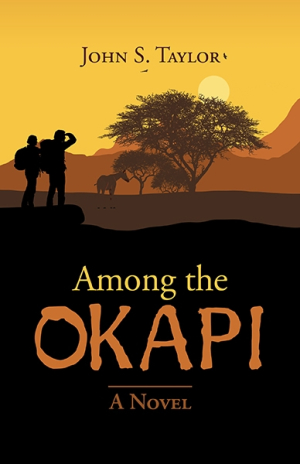Among the Okapi
Quiet symbols and fragile but enduring relationships populate the dramatic novel Among the Okapi, a modern parable about securing inner peace.
John S. Taylor’s novel Among the Okapi juxtaposes a professor’s experiences at a Canadian college and in an African rainforest where he conducted his research.
Smith’s discoveries about okapi (the forest giraffe) could have resulted in a prestigious career. Instead, he took a position at Waverly College to be close to Daphne, the sister of his deceased traveling companion, Alice. He’s almost over the loss of Alice when a politician and former mercenary lieutenant, Van Dusen, arrives at Waverly to help open its arts center, raising painful memories as he does.
Meanwhile, Smith enlists Fred, a hapless new lab demonstrator in his department, to help prepare his notes for a series of papers. The work comes at an opportune time: Fred’s landlady is evicting him for overdue rent. And a student, Esther, endears herself to Fred and Smith. The niece of Daphne and Alice, Esther evades the attention of her cousin Jason, who has returned to Waverly after a long estrangement. Jason’s heroic reaction to a stranger threatening Esther calls Fred’s doting into question. People’s true intentions are exposed at the arts center opening.
Between the comic beginning scene in which Fred escapes his fraught housing situation in a jalopy and the explosive ending scene at the arts center, various threads unravel like “the tentative knitting of the strands of his life into a stable fabric.” Esther is torn between Fred’s devotion to her and Jason’s confidence in her. And in Smith’s story, told most via his notes from Africa, Alice is caught between a government’s enemies and mercenaries. Humorous, tension-building passages convey people’s inner thoughts. These combine with heated confrontations, resulting in a propulsive pace: Fred and his landlady exchange harsh words. Smith calls Van Dusen out for his past crimes. Esther rejects a suitor.
The subject of Smith’s research is never discussed in the book, and the mice that Esther refuses to dissect in Fred’s class are also under addressed, though both prove to hint at the book’s conclusion. Indeed, the story is full of artistic and scientific references. And as its college setting and its domestic Canadian scenes combine with internal turmoil and verbal sparring, the story reaches a chaotic height. Then, a quiet observer emerges—John, Daphne’s husband and Jason’s father. At first on the periphery of the plot (working while Daphne sits on arts-related committees), he returns at its end to deliver a calming perspective and a confession. Though in some ways he feels an ill fit, he becomes the bearer of a subtle message about what truths need to be told and which can be left alone.
Quiet symbols and fragile but enduring relationships populate the dramatic novel Among the Okapi, a modern parable about securing inner peace.
Reviewed by
Mari Carlson
Disclosure: This article is not an endorsement, but a review. The publisher of this book provided free copies of the book and paid a small fee to have their book reviewed by a professional reviewer. Foreword Reviews and Clarion Reviews make no guarantee that the publisher will receive a positive review. Foreword Magazine, Inc. is disclosing this in accordance with the Federal Trade Commission’s 16 CFR, Part 255.

